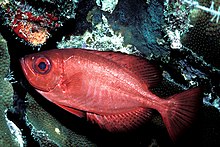Heteropriacanthus, the glasseyes or glass bigeyes, are a genus of the bigeye family found in all tropical seas around the world. It occasionally makes its way into the aquarium trade. It grows to a size of 50.7 cm (20.0 in) in total length.[2][3][4]
| Heteropriacanthus | |
|---|---|

| |
| Scientific classification | |
| Domain: | Eukaryota |
| Kingdom: | Animalia |
| Phylum: | Chordata |
| Class: | Actinopterygii |
| Order: | Perciformes |
| Family: | Priacanthidae |
| Genus: | Heteropriacanthus Fitch & Crooke, 1984 |
| Species: | H. cruentatus
|
| Binomial name | |
| Heteropriacanthus cruentatus (Lacépède, 1801)
| |
| Synonyms[1] | |
| |
The glasseyes has been classified in a single species, Heteropriacanthus cruentatus,[5] but recent morphological and genetic analysis indicates that glasseyes may be better divided into three species: Heteropriacanthus cruentatus (Atlantic Ocean and southwest Indian Ocean), H. fulgens (northeastern Atlantic), and H. carolinus (Indo-Pacific).[6] H.cruentatus can differentiated from the rest of its genus by looking at its caudal and anal fin in which is distinct in colour.[7]
References edit
- ^ "Heteropriacanthus cruentatus". WoRMS. World Register of Marine Species. Retrieved 9 April 2022.
- ^ Froese, Rainer; Pauly, Daniel (eds.) (2008). "Heteropriacanthus cruentatus" in FishBase. December 2008 version.
- ^ Eschmeyer, William N.; Fricke, Ron & van der Laan, Richard (eds.). "Genera in the family Priacanthidae". Catalog of Fishes. California Academy of Sciences. Retrieved 15 November 2020.
- ^ Lozano-Bilbao, Enrique; Domínguez, David; González, José A.; Lorenzo, José M.; Lozano, Gonzalo; Hardisson, Arturo; Rubio, Carmen; Weller, Dailos-González; Paz, Soraya; Gutiérrez, Ángel J. (June 2021). "Risk assessment and study of trace/heavy metals in three species of fish of commercial interest on the island of El Hierro (Canary Islands, eastern-central Atlantic)". Journal of Food Composition and Analysis. 99: 103855. doi:10.1016/j.jfca.2021.103855. S2CID 233935621.
- ^ Starnes, W. C., 1988. Revision, phylogeny and biogeographic comments on the circumtropical marine percoid fish family Priacanthidae. Bulletin of Marine Science, 43 (2): 117-203.
- ^ I. Fernandez-Silva and H.-C. Ho, 2017. Revision of the circumtropical glasseye fish Heteropriacanthus cruentatus (Perciformes: Priacanthidae), with resurrection of two species. Zootaxa 4273 (3): 341–361.
- ^ Gaither, M. R.; Bernal, M. A.; Fernandez-Silva, I.; Mwale, M.; Jones, S. A.; Rocha, C.; Rocha, L. A. (September 2015). "Two deep evolutionary lineages in the circumtropical glasseye Heteropriacanthus cruentatus (Teleostei, Priacanthidae) with admixture in the south-western Indian Ocean: two deep lineages in circumtropical heteropriacanthus cruentatus". Journal of Fish Biology. 87 (3): 715–727. doi:10.1111/jfb.12754. PMID 26333139.
External links edit
- Photos of Heteropriacanthus on Sealife Collection